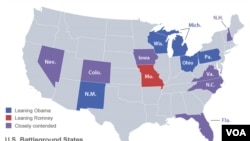As the U.S. presidential campaign heads toward the November 6 election, it appears the outcome will be decided in eight of the country’s 50 states.
Surveys in the eight battleground states show voters are closely split in deciding whether to give the Democratic incumbent, President Barack Obama, a second four-year term in the White House, or come January, make his Republican challenger, one-time venture capitalist Mitt Romney, the American leader.
While the surveys track voter sentiment for both candidates throughout the country, the national popular vote does not decide U.S. presidential campaigns. Rather, U.S. presidents are essentially elected in a collection of state-by-state contests, in a two-century-old electoral college system, with each state’s influence on the outcome roughly dependent on the size of its population.
Garnering state support
The goal for both candidates is to accumulate enough state wins throughout the country to reach a majority of 270 votes of the 538 available.
Early voting already is occurring in many states, but several independent analysts say that 42 states seem solidly in either Obama’s or Romney’s camp, or leaning that way. At the moment, that would leave Obama with a 237 to 206 electoral vote lead, assuming there are no unexpected upsets in any of these states.
As a result, Obama and his running mate, Vice President Joe Biden, and Romney and his running mate, Wisconsin congressman Paul Ryan, have made repeated campaign visits to the remaining eight states with a total of 95 electoral votes. They cancelled some campaign stops Monday, however, as Hurricane Sandy barreled toward the country's East Coast.
Surveys show tight race
Polls in recent days show Romney edging ahead of the incumbent in national voter sentiment, in part because of overwhelming support for him in some southern and western states. Those are the most conservative parts of the country that in recent elections have voted solidly for Republican presidential candidates.
But the surveys - at least for the moment - show a different story in the battleground states.
In these eight states, the polling of would-be voters shows Obama maintaining slight leads in five of them - the midwestern states of Ohio, Wisconsin and Iowa, as well as the northeastern state of New Hampshire and the western state of Nevada. If Obama wins these five states with 44 electoral votes, and holds the ones he is expected to carry, he would have 281 electoral votes, enough to win a second term in the White House.
Ohio looms large
Polling shows that Romney appears to have gained a narrow lead in the southern state of Florida, with 29 electoral votes, and is in close contests with the president in the mid-Atlantic state of Virginia and the western state of Colorado with another 22.
Numerous analysts say the bellwether state of Ohio, with its 18 electoral votes, is the key battleground. No Republican has won the White House without winning that state. It is a large state with three major cities - Cleveland, Columbus and Cincinnati - and numerous smaller towns. There are vast farmlands in Ohio, as well as major manufacturing plants.
The president and Romney have staged numerous campaign rallies in Ohio. Surveys have shown the president with an average two-percentage point lead. But if Romney were to overcome that lead and collect the state's electoral votes, he could win the election.
Surveys in the eight battleground states show voters are closely split in deciding whether to give the Democratic incumbent, President Barack Obama, a second four-year term in the White House, or come January, make his Republican challenger, one-time venture capitalist Mitt Romney, the American leader.
While the surveys track voter sentiment for both candidates throughout the country, the national popular vote does not decide U.S. presidential campaigns. Rather, U.S. presidents are essentially elected in a collection of state-by-state contests, in a two-century-old electoral college system, with each state’s influence on the outcome roughly dependent on the size of its population.
Garnering state support
The goal for both candidates is to accumulate enough state wins throughout the country to reach a majority of 270 votes of the 538 available.
Early voting already is occurring in many states, but several independent analysts say that 42 states seem solidly in either Obama’s or Romney’s camp, or leaning that way. At the moment, that would leave Obama with a 237 to 206 electoral vote lead, assuming there are no unexpected upsets in any of these states.
As a result, Obama and his running mate, Vice President Joe Biden, and Romney and his running mate, Wisconsin congressman Paul Ryan, have made repeated campaign visits to the remaining eight states with a total of 95 electoral votes. They cancelled some campaign stops Monday, however, as Hurricane Sandy barreled toward the country's East Coast.
Surveys show tight race
Polls in recent days show Romney edging ahead of the incumbent in national voter sentiment, in part because of overwhelming support for him in some southern and western states. Those are the most conservative parts of the country that in recent elections have voted solidly for Republican presidential candidates.
But the surveys - at least for the moment - show a different story in the battleground states.
In these eight states, the polling of would-be voters shows Obama maintaining slight leads in five of them - the midwestern states of Ohio, Wisconsin and Iowa, as well as the northeastern state of New Hampshire and the western state of Nevada. If Obama wins these five states with 44 electoral votes, and holds the ones he is expected to carry, he would have 281 electoral votes, enough to win a second term in the White House.
Ohio looms large
Polling shows that Romney appears to have gained a narrow lead in the southern state of Florida, with 29 electoral votes, and is in close contests with the president in the mid-Atlantic state of Virginia and the western state of Colorado with another 22.
Numerous analysts say the bellwether state of Ohio, with its 18 electoral votes, is the key battleground. No Republican has won the White House without winning that state. It is a large state with three major cities - Cleveland, Columbus and Cincinnati - and numerous smaller towns. There are vast farmlands in Ohio, as well as major manufacturing plants.
The president and Romney have staged numerous campaign rallies in Ohio. Surveys have shown the president with an average two-percentage point lead. But if Romney were to overcome that lead and collect the state's electoral votes, he could win the election.







